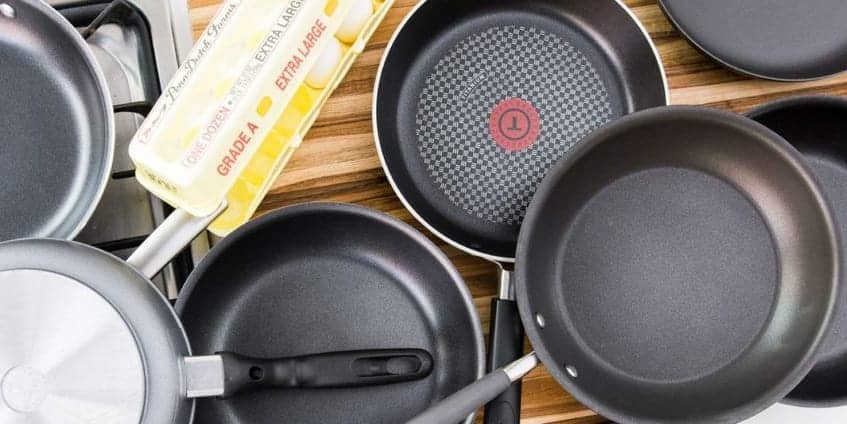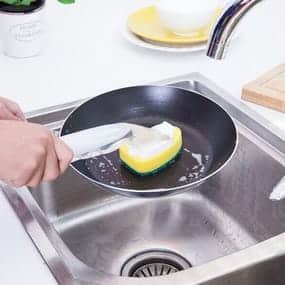How to Season a Nonstick Pan (And Cook Like A Chef)
You’ve just bought that new nonstick pan you’ve been wanting. But before you start using it, you’ll have to season it so you can cook like a chef in your own kitchen.
Every kitchen needs at least one nonstick pan. It’s essential to making the perfect omelet or scrambled eggs. Dessert crepes turn out precise each time. And cooking delicate fish, like sole, is easy with a nonstick pan. Cooking with nonstick cookware is also great for your health – no fats or oils needed to cook your food. You’ll be able to reduce fat and calories in your diet.

As easy and efficient as it is, your new nonstick pan needs a little care before you can start cooking. Here’s everything you need to know about how to season a nonstick pan, as well as how to care for one.
What is a Nonstick Pan?

Non-stick pans and pots are aluminum or stainless steel cookware that’s been covered with a non-porous coating. This coating creates a glossy and smooth surface that prevents foods from sticking to the bottom of the pan.
One of the most common coatings is PTFE (polytetrafluoroethylene), otherwise known as Teflon. The other common coating for non-stick pans is a silica-based gel, or a ceramic. Both are ideal coatings that prevent foods from adhering to the pan’s surface.
Do I Need to Season My Nonstick Frying Pan before I Use It?

Before using your nonstick pan, you’ll need to season it. Seasoning a nonstick pan will help fill in the small pits and pores in the surface of the pan. Seasoning helps with any inconsistencies in the finish of the pan and reduces the need to use any additional oil for cooking.
Another reason for seasoning your nonstick frying pan is to extend the life of the pan, so foods don’t start to stick. The oil you use to season the pan builds a protective layer of protection against oxidation.
This prevents rust from damaging the surface of the pan.
Some manufacturers recommend that you season the pan at least twice a year to ensure that it stays in good condition. Still other manufacturers recommend seasoning your pans every few weeks to keep them in top quality shape, so they continue to cook efficiently.
How to Season a Nonstick Pan?
Seasoning your non-stick pan is easy and takes only a few minutes:
Your seasoned pan is now ready for you to start cooking.
Seasoning Nonstick Pans In The Oven
You can also season the pan in oven – the result is the same as when pans are seasoned on the stove:

What would happen if I don’t?
It’s highly recommended that you take the time to season your nonstick pan. Otherwise foods will stick to the surface. You’ll then to need to start adding oil to the pan to prevent sticking, which defeats the purpose of using a non-stick pan or pot.
Once food starts to stick to the pan and gets into the pores of the surface, it can be difficult for your non-stick pan to work at its best. If this happens, immediately season the pan to fill in the pores. You may need to season it more than once.
Can you season a non-stick pan with olive oil?

Olive oil shouldn’t be used for seasoning your non-stick pan, even if some manufacturers approve of this oil for seasoning.
The reason for this is that olive oil has a relatively low smoke point, meaning the oil will start to break down at medium to high temperatures and start to smoke. Avoid using butter and other oils that also have a low smoke point.
The best oil to use for seasoning a nonstick pan is peanut oil. It has a very high smoke point. Canola and grapeseed oil are also good choices, with a tolerance to higher heat than other oils.
Can you season a Teflon pan?
A Teflon pan is just one type of nonstick pan, also known as a PTFE coating. As with ceramic coated pans, Teflon should be seasoned following the instructions here for seasoning a nonstick frying pan.
How to Clean and Care for your Nonstick Frying Pan?
Non-stick pans are great for ease of use, quick clean up, and for healthy fat-free cooking. Over time, non-stick pans can slowly start to deteriorate, particularly if they’re not cared for properly. The finish on the surface of the pan will start to wear off, making it less slick. When it comes to cleaning a non-stick pan, follow these guidelines:

A great storage technique is to buy cookware storage racks. They easily fit into the cupboard, with a separate space for each pan.
How do I Cook with My Nonstick Frying Pan?
There’s a right way and a wrong way to cook using your non-stick pan. These tips will help you get the most out of your pan and keep it in good shape for years to come:

What are the benefits of cooking with a non-stick pan?
There are some great advantages that come from cooking with your non-stick pan:
Whether you’re trying to lose weight or are just watching what you eat, cooking with less fat is one of the top reasons for owning non-stick cookware.

Now that you know how to season a non-stick pan, and how easy they are to care for and cook with, you’ll want more than one in your kitchen.
